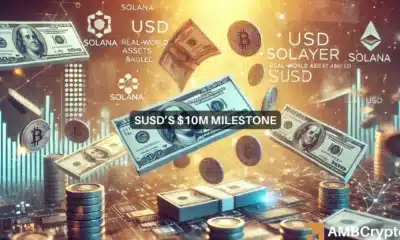Bitcoin
What Bitcoin’s rising hashrate means for you
Despite Bitcoin’s recent price dip, its surging hashrate indicates positive signs.
- Bitcoin’s hashrate hit new highs, signaling positive mining activity.
- Onchain trends revealed a preference for the coin’s movement amidst exchanges.
Bitcoin [BTC] experienced a substantial price downturn in recent days, causing concerns in the market. However, there was a positive development in the form of BTC’s hashrate, indicating resilience in the network.
If you want to know when #Bitcoin's fundamentals stop growing, just check the hashrate.
It keeps reaching all-time highs every month.https://t.co/IwcFXPKOjH pic.twitter.com/TX64aSwoLD
— Ki Young Ju (@ki_young_ju) January 16, 2024
Looking at the state of miners
The growth in BTC’s hashrate could be attributed not only to improvements in chip performance but also to the expansion of U.S. mining companies.
The presence of these mining companies has played a crucial role in boosting BTC’s hashrate, contributing to the overall health of the network.
The mining sector’s positive trajectory is further emphasized by the collective market cap of the largest mining companies, which stood at an impressive $13.6 billion.
This significant market cap indicated the financial strength and stability of these mining entities, reinforcing the positive outlook for BTC.
What’s next for BTC
Analyzing on-chain trends showed that people were actively moving coins instead of holding them at press time.
This suggested active engagement with BTC rather than a passive holding approach, potentially contributing to increased liquidity and trading activity.
$BTC update
As mentioned in previous weekly stats, onchain movement has favoured coin movement over accumulation
Both temporally (age of coin) + Economically ($ Value)
The thesis has playing out as proposed https://t.co/EHd4WTR9UI @santimentfeed pic.twitter.com/W0iL1PHCeI
— NeuroInvest Research (@Neuro__Invest) January 15, 2024
Will the halving double holder returns?
Looking ahead, analyst Tom Wan’s projection points to the approaching date of the next Bitcoin halving, set for the 15th of April 2024. During this event, block rewards will be halved from 6.25 to 3.125.
Read Bitcoin’s [BTC] Price Prediction 2024-25
Halving events historically have had a profound impact on BTC prices. As the next halving approaches, market participants may anticipate positive price movements.
As of the latest data, BTC was trading at $42,715.13, reflecting a modest growth of 0.4% in the last 24 hours. The increased trading volume further supported the notion of active participation in the king coin’s market.
